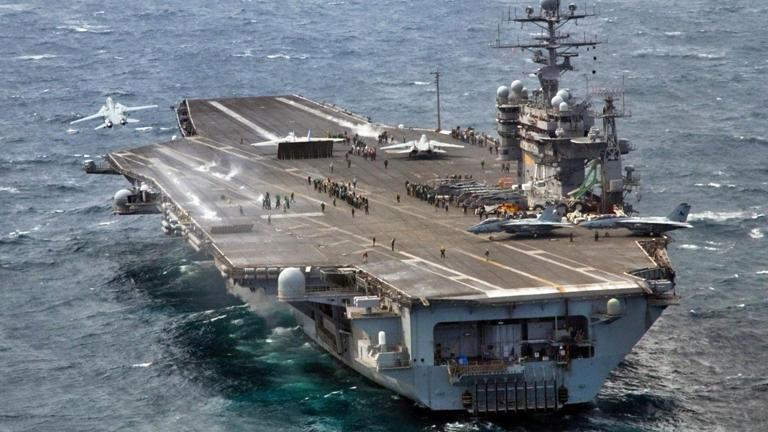
Houthis Say U.S. Navy Aircraft Carrier Will Be ‘Targeting Upon Arrival’
The USS Dwight D. Eisenhower (CVN-69), a Nimitz-class nuclear-powered aircraft carrier, has departed the Red Sea after an extended deployment that began following the October 7 Hamas terrorist attack on Israel. The carrier spent much of its deployment protecting commercial and military vessels from Houthi rebel attacks in the Red Sea and Gulf of Aden.
Despite unsubstantiated claims by the Houthis that they had inflicted damage on the Eisenhower, the U.S. Navy stated that the carrier group demonstrated a strong commitment to regional stability and freedom of navigation.
The Eisenhower is being replaced by the USS Theodore Roosevelt (CVN-71), which will continue the mission in the region.
Houthi Rebels Claim Victory as USS Eisenhower Departs the Region
Elvis has not left the building – but last month, the United States Navy’s Nimitz-class nuclear-powered aircraft carrier USS Dwight D. Eisenhower (CVN-69) departed the Red Sea. The warship transited the Suez Canal and began her long journey back to the United States, following an epic deployment that began just weeks after the October 7 Hamas terrorist attack on Israel.
The second oldest nuclear-powered carrier in service spent nearly the entirety of her deployment – extended multiple times – in the Red Sea and Gulf of Aden to protect commercial and military vessels from the Yemeni-based Houthi rebel militant group, which is supported by Iran. The Houthis had targeted shipping in the region, allegedly in support of Hamas, and in the past several months had claimed – without any proof – that it had inflicted serious damage on U.S. military vessels, including CVN-69.
The departure of USS Dwight D. Eisenhower also allowed the group to claim a de facto victory, although it was in contrast to the official statement released by U.S. Central Command (CENTCOM).
“Flying over 30,000 hours and sailing over 55,000 miles the IKE CSG demonstrated our commitment to regional stability and protected freedom of navigation throughout the Red Sea and Gulf of Aden,” CENTCOM wrote in a post on X, the social media platform formerly known as Twitter.
Even with “unlimited” endurance, the U.S. Navy’s Nimitz-class supercarriers can’t stay deployed forever, and it has been reported that the warship and other elements of her strike group have been engaged in some of the most intense combat operations since the Second World War.
Exit the Ike, Here Comes The Big Stick
The U.S. Navy isn’t leaving the Red Sea unprotected, as multiple warships remain, while another supercarrier is now en route.
“Following completion of a scheduled exercise in the Indo-Pacific, the USS Theodore Roosevelt (CVN 71) Carrier Strike Group will enter the CENTCOM Area of Responsibility bringing with it capabilities that enhance CENTCOM’s ability to deter aggression, safeguard regional stability, and protect freedom of navigation in the region,” CENTCOM added in its social media announcement.
CVN-71 and her carrier strike group (CSG) on Saturday concluded its participation in the Freedom Edge – the U.S. Navy’s inaugural, trilateral, multi-domain exercise with Japan and South Korea. Nicknamed “The Big Stick” by her crew, USS Theodore Roosevelt will arrive in the Red Sea in the coming weeks.
Houthi Vows to Sink Aircraft Carrier
Last month, the Houthi rebels made several completely unsubstantiated claims that its missiles and drones had successfully struck USS Dwight D. Eisenhower and her escorts. Photos and videos were posted to social media as part of a highly coordinated misinformation/disinformation campaign – and subsequently picked up by regional media in the Middle East, which reported it as fact.
The U.S. Navy responded by releasing its own videos that highlighted that it was business as usual on the carrier and other warships.
Even as CVN-69 has departed from the region, the Houthis are upping their social media game, and this week began sharing a video on X and other platforms in which it claims it will sink USS Theodore Roosevelt. The more than a-minute-long video seems to have used actual U.S. Navy footage, and warned that the carrier “will be under targeting upon its arrival.”
How exactly the Houthis expect to do any better against USS Theodore Roosevelt than it did when confronting USS Dwight D. Eisenhower wasn’t explained. Yet, it is now clear that the war online will likely be harder to win than the one at sea.
Source » msn.com





